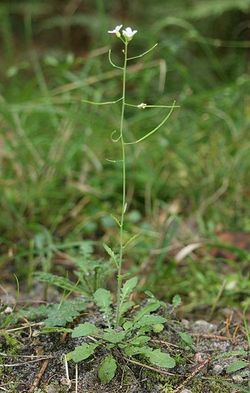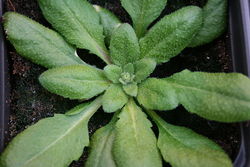| Mouseear cress |
 |
| Scientific Classification |
|
|
| Binomial Name |
| Arabidopsis thaliana |
|
|
| Thale cress |
Mouseear cress (Arabidopsis thaliana) is a weed native to Eurasia and northern Africa. It has also spread to other continents, and is a common model organism in plant molecular biology. It is a member of the mustard family (Brassicaceae), along with cabbage and raddishes, although it has no nutritional value.
Life cycle
A. thaliana can grow in a wide range of soil types, in regards to texture, acidity, and moisture.[1] It can also grow in either partial shade or full sun.[1]
Seeds generally germinate three days after planting, and the first leaves form at 7-10 days.[2] Flowering time varies depending on ecotype.[3] The plant's entire life cycle can be completed in one to two months.
History
A. thaliana was discovered in 1577 by Johannes Thal in northern Germany. Mutants have been identified as early as 1873.[4] Collections of mutants were first made in the 1940s.[4]
In the laboratory
Biological scientists often study model organisms, which are easy to study in the laboratory, to learn more about biological principles that also apply to other organisms. A. thaliana has many characteristics that make it a good model organism for plants. It is small and grows fast. It can grow well in soil and in liquid culture.[5] The Arabidopsis genome has only 70,000 base pairs, which makes it one of the smallest plant genomes.[5] It was also the first plant genome to be completely sequenced. The plant's molecular biology is relatively simple. Other plants often have large gene families, which are multiple genes that are similar in structure and have the same function. In most cases, Arabidopsis only has one gene for a particular function.[5]
The Arabidopsis genome can be altered by using Agrobacterium tumefaciens, a bacteria that is able to insert plasmid DNA into a plant. Agrobacterium transformation can either knock out existing genes or introduce new genetic material.
Large collections of mutant lines have been generated and made available for researchers to order. For example, the Arabidopsis Biological Research Center at The Ohio State University has almost one million seed lines, most of which are mutants.[6]
It is assumed that the identification of genes in Arabidopsis will make it easier to determine the function of genes in other plants.
The U.S. National Aeronautic and Space Administration, in collaboration with the European Space Agency, has performed experiments on Arabidopsis onboard the International Space Station in order to determine how growth in space affects gene expression and other physiological processes in plants. A study of proteins associated with the endoplasmic reticulum membrane found that 149 proteins had significantly different levels of expression in microgravity.[7] In general, proteins associated with protein and hormone transport were downregulated, and proteins associated with defense, the stress response, and metabolism were upregulated.[7] Because space is a low-gravity environment, the gravitropic response is another function that is important to study. In spaceflight, the direction of root growth was found to be determined by light, rather than gravity.[8]
References
- ↑ 1.0 1.1 Minx, Patrick. Genome: Arabidopsis thaliana. McDonnell Genome Institute at Washington University. Accessed 16 May 2016.
- ↑ Developmental stages (Life cycle). GeoChemBio.com. 18 May 2013. Accessed 17 May 2016.
- ↑ Arabidopsis Ecotypes and Geographic Distribution of Arabidopsis. Via Arabidopsis Information Resource. Accessed 17 May 2016.
- ↑ 4.0 4.1 Meyerowitz, Elliot. History of Arabidopsis thaliana as a research organism. Via Arabidopsis Information Resource. 1998. Accessed 16 May 2016.
- ↑ 5.0 5.1 5.2 Mader, Sylvia S. (2007). Biology, Ninth Edition. New York, NY: McGraw-Hill. p. 490-491. ISBN 0-07-325839-3.
- ↑ Resources. Arabidopsis Biological Research Center. The Ohio State University. Accessed 16 May 2016.
- ↑ 7.0 7.1 Mazars, C., et al. (2014). "Microgravity induces changes in microsome-associated proteins of Arabidopsis seedlings grown on board the international space station." PLoS One 9 3: e91814
- ↑ Paul, A., Amalfitano, C.E., and Ferl, R.J. (2012). "Plant growth strategies are remodeled by spaceflight." BMC Plant Biol 12: 232.


